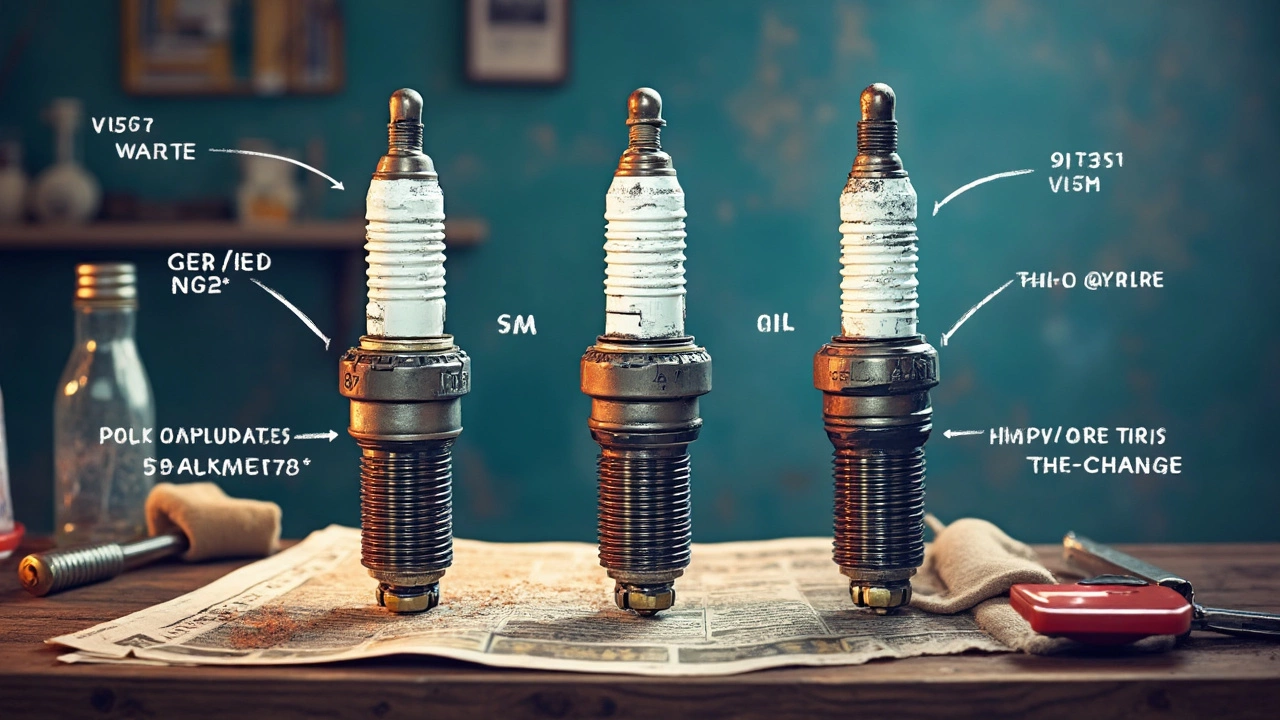 Jun, 17 2025
Jun, 17 2025
Still running your car on its original spark plugs? You might want to think again. Those tiny parts are the spark behind every engine start, and they don’t last forever.
Car makers usually suggest changing standard copper spark plugs every 20,000 to 30,000 miles. But if you’ve got the fancier platinum or iridium kind, your window stretches closer to 60,000—or even 100,000 miles in some cases. You’ll find this info in your manual, but let’s be honest—who reads that cover to cover?
Ignoring old spark plugs is like drinking from a cracked mug. It’s not a problem right away, but little issues start adding up. Bad starts, rough idling, crummy gas mileage—these are all shouting at you to look under the hood. Swapping them out isn’t just about numbers; it’s about keeping your car happy and saving cash on fuel or repairs down the line.
- What Spark Plugs Do and Why They Matter
- Recommended Change Intervals (By Type and Car)
- Signs It’s Time for New Spark Plugs
- Risks of Ignoring Spark Plug Maintenance
- Practical Tips for Spark Plug Care
What Spark Plugs Do and Why They Matter
Spark plugs might look tiny, but they’re the reason your car starts at all. Every time you turn the key, they create a small electrical spark that lights up the air and fuel mix inside the engine. Without that, you’re stuck going nowhere fast.
Each cylinder in your engine gets a spark plug. These fire off in a fast, perfect rhythm as you drive. The timing has to be spot-on—if it’s even a little off, your engine acts up. So yeah, spark plugs aren’t just for the checklist. They literally keep things moving.
Besides just making sparks, they help keep your engine running smooth and efficient. Old or bad plugs mean your engine has to work harder, which leads to:
- Rough idling (feels like your car’s shaking or stumbling at stoplights)
- Harder starts, especially when it’s cold
- High fuel use—your car actually wastes more gas
- Less power or slow acceleration
Here’s a quick look at how often you’ll run into trouble depending on your spark plug type:
| Plug Type | Average Lifespan (Miles) |
|---|---|
| Copper | 20,000 – 30,000 |
| Platinum | 60,000 – 80,000 |
| Iridium | 80,000 – 100,000 |
One more thing that surprises a lot of folks: Because spark plugs have to handle temps over 1,500°F, not just any old metal will do. That’s why newer spark plugs use exotic materials—they last way longer and give better sparks, especially in newer cars.
So, if you want your car to stay smooth, save on gas, and not leave you stranded, checking your spark plugs is up there on the to-do list. They’re a lot more central to your daily drive than most people guess.
Recommended Change Intervals (By Type and Car)
Not all spark plugs are made the same—there are copper, platinum, double platinum, and iridium types. Each lasts a different amount of time before needing a swap. Want the quick numbers? Here’s a no-nonsense table showing what you can expect for each type:
| Spark Plug Type | Average Lifespan (Miles) | Typical Change Interval | Common in... |
|---|---|---|---|
| Copper | 20,000–30,000 | Every 2–3 years | Older cars, budget models |
| Single Platinum | 40,000–60,000 | Every 4–5 years | Modern sedans, some SUVs |
| Double Platinum | 60,000–100,000 | Every 6–8 years | High-mileage vehicles |
| Iridium | 80,000–120,000 | Every 7–10 years | Newer cars, performance models |
If you’re like most drivers, you may not even know what kind of spark plugs your car uses. Pulse check: pop the hood, or just check the owner’s manual (yes, that dusty book in your glovebox). The car’s make and model seriously matter. Some Toyota and Honda engines, for example, now come with iridium plugs designed to outlast your urge to buy a new car. Meanwhile, older pickup trucks with basic copper plugs will cry for attention much sooner.
Got a modern Ford F-150 or Chevy Silverado? Odds are it’s running on double platinum or iridium—trust them to keep going past the 90,000-mile mark. Meanwhile, budget-friendly rides like older Kia Rios or early 2000s sedans usually have copper plugs you need to swap every second or third oil change.
The easiest way to stay ahead is to jot down your mileage after a tune-up. Go by your car’s service schedule, but if you’ve just gotten spark plugs changed or switched plug types, it’s a smart move to set a reminder in your phone for when the next change is due. Technology can do more than just tell you the weather.

Signs It’s Time for New Spark Plugs
Most people don’t think about spark plugs until their car acts up. But your ride will usually throw out some warning signs before those plugs flat out quit. Knowing what to look for can save you a world of trouble.
Here’s what you should keep an eye—and ear—out for:
- Trouble starting the engine: If your car suddenly needs a few extra tries to fire up, old spark plugs might be the culprit. They lose their spark strength over time, making ignition harder.
- Rough idling or strange engine sounds: When spark plugs go bad, you might feel your car vibrating more at idle. Clicking or knocking noises can also show up, especially at red lights.
- Poor acceleration: If pushing the gas pedal doesn’t give you that kick it used to, worn plugs could be to blame. The engine’s just not getting enough spark to work efficiently.
- Drop in fuel efficiency: A sudden dip in miles per gallon? Bad spark plugs make your engine work harder and burn more fuel than it should.
- Check engine light: Modern cars will tattle on you. A flashing check engine light often means there’s a misfire—something a worn spark plug can easily cause.
Not sure if these signs match your car’s weird behavior? Here’s a quick tip: Pull out the suspect plug and check its tip. A healthy spark plug should look light gray or tan with minimal buildup. If it’s black, oily, or covered in deposits, it’s definitely overdue for a change.
As the guys at Car and Driver put it:
“If your engine starts misfiring, hesitating, or you’re seeing a noticeable decrease in power, don’t wait—get those spark plugs checked out.”
Spotting these symptoms early means less hassle and smaller repair bills. Even if one plug is out, it’s smart to change the whole set. That way, your engine runs evenly—no weak links.
Risks of Ignoring Spark Plug Maintenance
If you keep pushing off spark plug maintenance, the problems pile up faster than you might think. Your engine relies on those plugs for every single start and for smooth running. Forget about them and it ends up costing you—not just money, but time and peace of mind.
Here’s what actually happens when you ignore spark plug care:
- Car maintenance takes a hit—your engine has to work harder, burning more fuel and wearing itself down.
- You get rough starts and sometimes the car just won’t fire up at all, especially when it’s cold out.
- The check engine light is more likely to pop on, leading to failed emissions tests. Serious fail if you live in a state that actually checks.
- Your acceleration drops off and the car starts to jerk or misfire, which doesn’t feel good for anyone riding with you.
- Fuel economy tanks. The Department of Energy (DOE) says misfiring plugs can cut fuel economy by up to 30%—that’s like tossing a third of your gas money out the window.
Want the numbers? Here’s a quick rundown of what you risk:
| Problem | Potential Impact |
|---|---|
| Misfires | Rough idle, stalling, loss of power |
| Poor fuel economy | Up to 30% more fuel used |
| Damage to other parts | Fouled catalytic converter & ignition coils |
| Longer engine life | Reduced by avoidable stress |
Dragging your feet here can even kill your catalytic converter, which is one of the most expensive repairs most of us will face—think $1,000 or more. If your check engine light keeps flashing because of ignored plugs, you’re just asking for trouble at inspection time too.
The bottom line is simple: keep those plugs fresh if you want your ride to last, save cash on repair bills, and avoid those annoying mornings when your car refuses to start.

Practical Tips for Spark Plug Care
Keeping your spark plugs in good shape isn't rocket science, but it pays off with smoother starts and better fuel economy. Follow these hands-on tips, and you’ll keep engine trouble at bay longer.
- Check spark plugs every 15,000–20,000 miles, even if you’ve got long-life plugs. A visual check lets you spot wear before it turns into a real headache.
- Look for gunk or a burnt tip—both mean it’s time for a swap. Clean-looking plugs could still be worn down, so always check your mileage too.
- Don’t over-tighten when installing new ones. Hand-tight and a small turn with the wrench is usually plenty. Too tight? You risk cracking the ceramic.
- Always use a plug socket with a rubber insert. This keeps you from accidentally breaking the new plug during install.
- If your engine sounds rough or you’re getting worse gas mileage, don’t wait for the check engine light. Sometimes the light isn’t fast enough.
Not sure how your plugs are doing? Pop the hood yourself if you're comfortable, or just ask your mechanic to show you the spark plugs at your next oil change. It’s five extra minutes, tops.
For folks who want some hard numbers, here’s a quick stats sheet based on plug types and real-world lifespan:
| Type | Average Lifespan (Miles) | Replacement Cost (per plug, USD) |
|---|---|---|
| Copper | 20,000–30,000 | $2–$6 |
| Platinum | 60,000 | $6–$12 |
| Iridium | 80,000–100,000 | $8–$16 |
If you drive in a lot of stop-and-go traffic or your area gets really dusty, check a little more often. Those conditions wear things out faster. And just a quick reminder—stick to what your car’s manual suggests. The wrong plug or the wrong gap can mess with performance and even damage your engine over time.